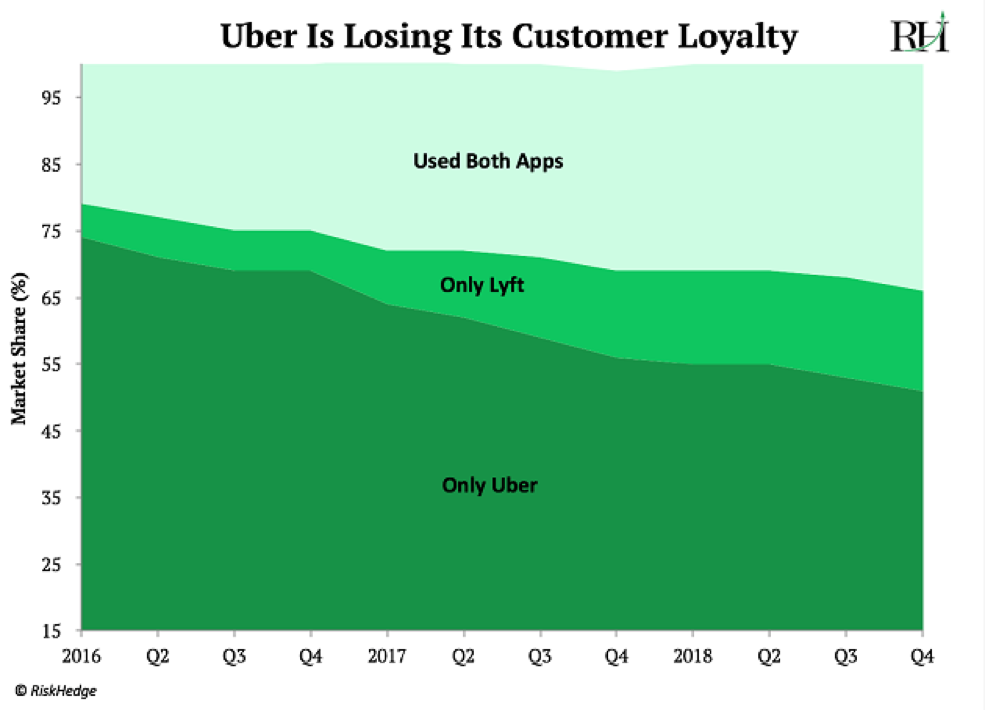Now, if you are losing money and can’t cut your expenses, your only option is to raise prices.
The problem is Uber is in a stalemate position where it can’t hike its fares.
A never-ending price war with Lyft…
The US is Uber’s biggest and most profitable market. But here, it has one big challenge.
You’ve probably heard about Lyft, Uber’s biggest competitor in the US.
These two companies have battled each other in price wars for years to undercut taxi fares and steal customers from each other.
It’s estimated that they’ve lost a combined $13 billion… and both still have no roadmap to profitability.
In other words, Uber is locked in a price war with Lyft.
As I’ll explain later, the moment Uber raises fares, its customers will switch to Lyft or another competitor.
But Uber’s problems with the competition don’t end here…
Uber can’t keep up with cutthroat competition overseas…
Another way Uber could raise its profits would be to grow globally.
But here, Uber’s prospects look even grimmer.
Bolt, an Estonia-based ride-sharing company, is quickly taking over Europe. In a lot of European cities, it’s a #1 ride-hailing app already.
It’s a heavy blow to Uber’s growth potential in Europe.
For example, London has been one of the biggest, most profitable markets for Uber. For years, Uber enjoyed zero serious competition in this city. Now it has Bolt.
Elsewhere Uber has already lost the battle with local competitors:
It has exited Russia after losing the battle with Yandex.Taxi…
It has exited China after losing the battle with DiDi…
And it has exited Southeast Asia after losing the battle with Grab and Go-Jek.
Southeast Asia accounts for more than 70% of the global ride-sharing market.
And these competitors are not just a local problem. Just like Uber, they have set their sights on the global market.
Take Brazil, where Uber boasts an 80% market share. It could be a money-making machine for Uber. And yet, the company bleeds money in Brazil because it’s fighting a price-war with China’s ride-sharing giant DiDi.
It’s a race to the bottom, which forces Uber to keep prices low and marketing expenses high.
Uber customers don’t care about Uber…
Would you take a ride with Uber if it cost twice as much as Lyft? That’s how much Uber needs to raise its fares to start earning money.
Probably not…
That’s because Uber’s app is no different from its competitors. It has no customer loyalty whatsoever.
In fact, more than 34% of people in the US who use ride-hailing services use both apps, Lyft and Uber. That’s up 50%+ from two years ago, according to Vox.

Many people switch back and forth between Uber and Lyft, choosing whichever one offers a better price at the moment.
And with its fierce competitors charging about the same or lower fares, this makes it impossible for Uber to raise prices.
Meanwhile, Uber is losing its market share not only globally but also in the US, as you can see in the above chart.
Let me say this one more time: It’s a race to the bottom.
Uber is worth no more than $20/share
Uber is currently trading for 4X sales. In short, this means Uber’s value is 4X greater than its annual sales.
For perspective, that’s more expensive than Amazon or Apple.
My research shows 3X sales is a fair price, if we are really generous.
The problem is, at 3X sales, Uber is worth no more than $20 to $22/share. And that’s currently 30% below its price.
That’s where I see the stock going in the coming years.
The Great Disruptors: 3 Breakthrough Stocks Set to Double Your Money”
Get my latest report where I reveal my three favorite stocks that will hand you 100% gains as they disrupt whole industries. Get your free copy here.








